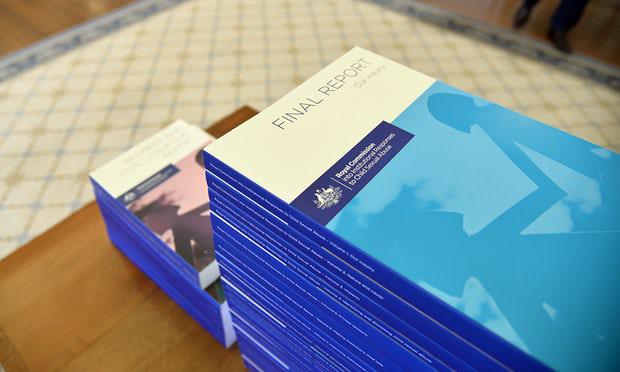|
Child sexual abuse royal commission: recommendations and statistics at a glance
The Guardian
December 15, 2017
https://www.theguardian.com/australia-news/2017/dec/15/child-sexual-abuse-royal-commission-recommendations-and-statistics-at-a-glance
 |
| The final report of the royal commission into institutional responses to child sexual abuse before the signing ceremony at Government House in Canberra on Friday. |
The Australian royal commission into the institutional responses to child sexual abuse has handed down its final report. Here are the key points
Key recommendations
The royal commission’s final report (pdf) has made 189 new recommendations, including:
-
The federal government should establish a National Office for Child Safety, sitting within the department of prime minister and cabinet. Its first job should be to develop a national framework to prevent child sexual abuse.
-
The federal government should create a portfolio overseeing policy towards children
-
All institutions should implement a list of child safe standards identified by the royal commission, to be enforced by federal, state and territory governments
-
Parish priests should no longer be the employers of principals and teachers in Catholic schools
-
There should be no exemption to mandatory reporting for child sexual abuse disclosed during a religious confession
-
The Australian Catholic bishops conference should request the Holy See to amend a series of church laws relating to child sexual abuse, including removing the requirement to destroy documents under certain circumstances, and to consider introducing voluntary celibacy for diocesan clergy
-
Anglican bishops should be accountable to an appropriate body in relation to their response to complaints of child sexual abuse
-
Federal, state and territory governments should make laws to protect people who report child sexual abuse in good faith
-
Institutions that engage in child-related work should retain records relating to child sexual abuse for at least 45 years
-
The government should conduct and publish regular surveys on the extent of maltreatment of children in institutional and non-institutional contexts
-
The federal government should establish and fund a legal advice and referral service for victims and survivors of institutional child sexual abuse.
Statistics
Some statistics published by the royal commission vary slightly. These are sourced from the final information update.
-
The royal commission heard evidence from almost 8,000 witnesses in private sessions, received 1,344 written accounts and held 444 days of public hearings
-
The evidence related to 3,489 institutions
-
Most survivors (63.6%) were male
-
93.8% were abused by a male
-
83.8% of survivors said they were abused by an adult
-
More than half of survivors were between 10 and 14 when they were first abused. The average age of victims when first abused was 10.4 years
-
The average age of survivors at the time of their private session was 52. The youngest to attend a private session was seven; the oldest was 93
-
More than a third (36.3%) said they were abused by multiple perpetrators
-
Child sexual abuse experienced in institutions continued for an average of 2.2 years
-
Abuse took place most commonly in an institution managed by a religious organisation (reported by 58.1% of survivors). Government-run institutions accounted for 32.5% and non-government, non-religious institutions for 10.5%.
-
Of those abused in a religious institution, 61.4% were in a Catholic institution, 14.8% Anglican, 7.2% Salvation Army and the rest in various denominations
-
As a proportion of all survivors, 35.7% were in a Catholic institution and 8.6% in an Anglican institution
-
More than one in three survivors (35.2%) said they were sexually abused in out-of-home care, primarily residential institutions such as children’s homes
-
Just under one-third (31.6%) said they were abused in a school, and 14.6% said they were abused while involved in religious activities, such as attending a church or seminary
-
The most common occupations of those identified as perpetrators were a person in religious ministry (31.8%), teacher (20.4%), residential care worker (13.5%) and foster carer (11.3%)
-
More than one in five survivors (21%) said they were sexually abused in more than one institution.
-
Aboriginal and Torres Strait Islander people represented 14.9% of survivors
-
4.2% of survivors had a disability at the time of the abuse
-
More than one in 10 of the survivors who gave evidence were in prison at the time of their private session
-
The commission has referred 2,562 matters to police.
|
